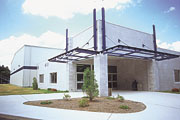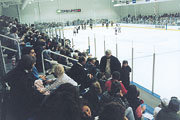Now UConn has its sights set on duplicating that success with its ice hockey program, hoping to someday compete with the Harvards and Boston Universities of the world. The school in the small town of Storrs, CT took a major step in that direction recently by building the University of Connecticut Ice Arena on the outskirts of campus.
The gleaming facility seats slightly more than 1,800 and stands in an athletic complex alongside football, soccer, and baseball fields and tennis courts. "Everybody's delighted with it," says Ron Dubois, associate director of athletics for facility planning, UConn.
According to Dubois, the main purpose of the new ice arena is to support UConn's men's varsity ice hockey program. The Huskies play in the Mid-Atlantic Athletic Conference, a new hockey league formed for Division I schools that aspire to play "big-time" hockey. Teams in the conference include other northeastern schools such as Iona, Holy Cross, Sacred Heart, Fairfield, and Canisius. But the arena actually sees its greatest use from intramural and recreational programs. The school presently offers a fall and winter intramural hockey program along with public skating for students, staff, faculty, and the community. It rents the ice to local groups for youth hockey, men's leagues, figure skating classes, birthday parties, and other functions.
"On a typical winter weekend, we have 2,000 people in there easily over a two-day period," Dubois says.
UConn plans to operate the ice rink year round to meet the public demand for ice skating and hockey. But operating in summer poses a major hvac challenge: maintaining a slab of ice while minimizing energy costs and keeping the building from fogging.

Humble Beginnings
The arena actually began life in 1963 as an outdoor rink with an open-sided roof. Exposure to the elements brought problems with leaves blowing onto the ice in fall and snow in winter, not to mention cold-weather injuries.Spartan amenities included a makeshift wooden building for a warming hut and limited restroom facilities. There was no locker room. After so many years of putting up with these conditions and wanting to upgrade its hockey program, the school faced a decision, Dubois recalls: "Either you turn it into a totally recreational rink and leave it that way, or you create an enclosed arena so you can play varsity hockey and service the community better."
UConn officials decided to build the arena around the existing ice slab and refrigeration system. "They left the mechanical room; everything else is new," says Bill MacDonald, hvac shop supervisor in UConn's Office of Facilities. Besides the ice rink, the building has an ancillary area that houses six locker rooms, coaches' offices, a meeting room, concession stands, novelty stand, officials' room, hospitality room, first-aid room, ticket office, lobby, and skate rental area. A metal building with a structural steel roof encloses the ice arena. The ancillary section uses masonry block construction.
According to John Alvarez, senior project manager, UConn, the project to build the new arena took a modified, or hybrid, design-build (D-B) form. UConn chose Design Forum (West Hartford, CT) as the architect, based largely on its experience in designing ice rinks. A "bridging team" worked for the owner, consisting of Design Forum and engineering consultants they hired. This included Van Zelm Heywood & Shadford (West Hartford, CT) as the MEP engineering firm.
The team laid out performance criteria for the facility and generated architectural drawings. These were given to design-builder HRH Atlas (Stamford, CT), a general contractor that hired its own MEP engineer, DLB Consulting Engineers (Stratford, CT), to work out the details as the engineer of record. The project started with a budget of about $3.1 million, but this grew as items were added, resulting in a $4.1 million project. The team saved $500,000 by not having to put in a new refrigeration system for the ice.

Dealing With Two Animals
From an hvac standpoint, the ice arena and ancillary area with offices and other rooms are like two separate buildings, with the ice arena posing the biggest problem. Officials opted for air conditioning in the arena so they could use it in summer."We know we designed the system so it could take care of the hottest days and still maintain good rink conditions," says Dubois.
Al Lewindowski, energy manager at UConn, was also concerned about ice quality, based on his previous experience with ice rinks. "If you don't dehumidify properly, you get poor ice."
According to Ernie Domingue, senior engineer with Van Zelm Heywood & Shadford, the team was looking at a very low dewpoint with the cold air temperature inherent with a large ice sheet in the building.
"In a place like that, where you have a lot of occupants and keep it at 50°F, which is ideal, some people tend to get too cold," says Domingue. "You don't want to make it too uncomfortable for everybody, and at the same time, you don't want to raise the indoor air temperature to the point where you're using a lot of electricity to keep your ice."
With that in mind, design conditions were set at 55°F at 50% rh, which is standard for ice arenas as specified in ASHRAE guidelines. At these conditions, Domingue says, "There's not much moisture in the air"; this translates to 32 grains of moisture/lb of dry air.
Besides dehumidification, air-handling units also would have to provide enough outside air to meet ASHRAE 62-89 ventilation standards, which Connecticut recently adopted. "You have to introduce that outside air and meet the internal space requirements of that 55°F at 50% rh, 32 grains," says Domingue. "To do that, you have to dehumidify."
The Desiccant Answer
As part of the design criteria, the UConn bridging team stipulated the use of a desiccant dehumidification system with a regenerative-type desiccant wheel. "Because of the energy conservation in mind, we also selected a unit that includes a heat recovery wheel, so you don't take all your nice dehumidified air and just dump it back outside," says Domingue.Lewindowski pushed not only for a desiccant dehumidification system, but also for using natural gas to regenerate the desiccant. "If you don't go with gas, you're asking for trouble," he states, comparing it with electricity.
The contractor's design team proposed using energy recovery units to meet the performance specs and handle all the ice arena hvac functions. Richard Peck, P.E., of W.W. Rothmann Co. (Mystic, CT), the area's rep for Des Champs (Natural Bridge Station, VA), proposed two Model PV-22 units. The ancillary section of the building would use two packaged rooftop units as part of a variable air volume (vav) system with direct-expansion (DX) coils for air conditioning and gas-fired heat.
According to Lewindowski, "There was quite a potential for energy savings" in using desiccant dehumidification. Figures showed the school would save 25% on operating costs. Moreover, both the university's electric and natural gas utilities offered rebates for using such a system. UConn's gas supplier, Connecticut Natural Gas, gave the school the best deal based on the system's efficiency.
Rated at a nominal capacity of 22,000 cfm, each energy recovery unit has a 60-in.-dia desiccant wheel, a 90-in.-dia total energy recovery wheel, and a DX coil for air conditioning. The energy recovery wheel uses a molecular sieve desiccant and the desiccant wheel a silica gel, each with a synthetic media matrix.
Each unit has an 80-ton, air-cooled condensing unit for cooling, and two 400-MBh, indirect-fired gas heaters for heating. A direct-fired gas heater, rated at 750 MBh and with a 2,800-cfm fan, regenerates the desiccant wheel.
The units mount on a concrete slab behind the building. A supply air duct runs along the walls on each side of the arena near the rafters, while return air ducts exit lower (toward the middle of the building).
A Mode for Every Occasion
To meet the various conditions of arena operation, the units operate in three modes.1. "Event mode" comes during a hockey game or similar scenario with the arena near capacity; outside airflow is 15,736 cfm and recirculation flow is 7,000 cfm.
2. "Normal occupied mode" is the typical mode of operation with few spectators, such as during hockey practice or public skating. Outside air flows at 8,236 cfm and recirculation air flows at 14,400 cfm.
3. In the "unoccupied mode," outside airflow shuts off and 100% recirculation prevails.
Converting the former outdoor rink to four-season indoor use also involved other changes. Contractors poured a 6-in.-thick concrete slab over the old one for the ice surface. Polyethylene pipes run through the new slab, and glycol solution circulates through these to make ice. Water cooling was added for the compressor oil in the ice-making refrigeration system, since it will see higher temperatures in summer.
Having opened the arena in October 1998, UConn now has one successful hockey season under its belt. The school has already operated the arena during warmer months on occasion, and witnessed the effectiveness of the dehumidification system.
"Before we ran the units, it was like a fog bank in there," says McDonald. "So we know they work."
With the arena's hvac system in place and functional, UConn can look forward to full-season skating and hockey for both the school and community. "We can rent every minute that's available out there to youth hockey or what have you," says Dubois.
And, who knows? Maybe they'll add a championship ice hockey trophy next to the one for its men's basketball feat. ES
